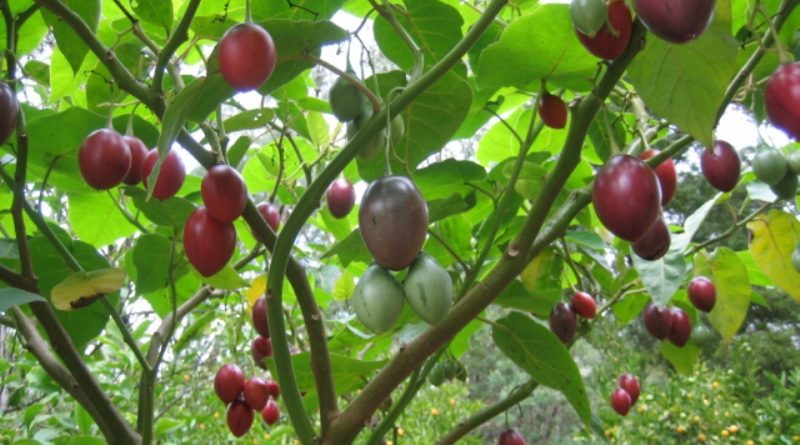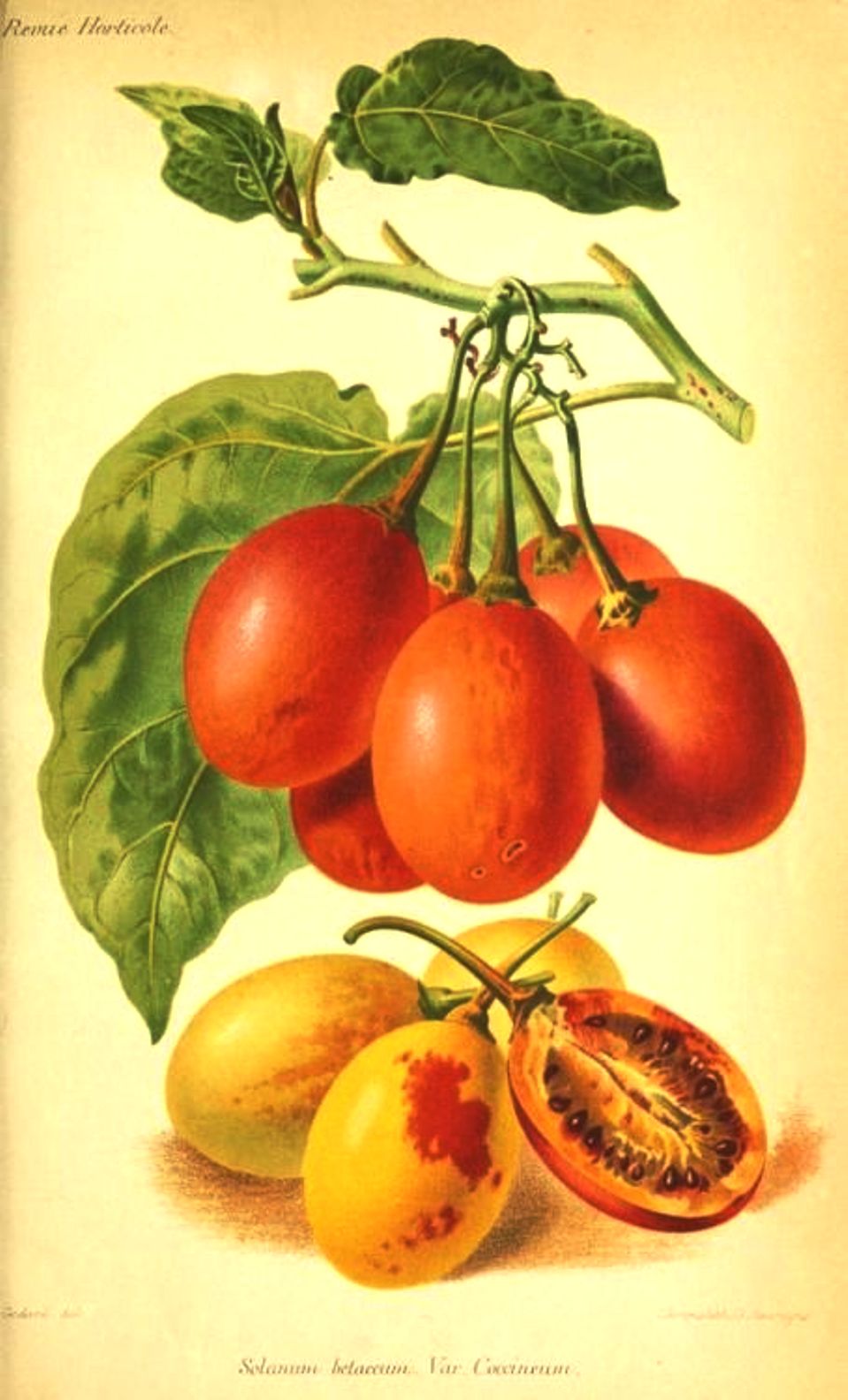Cyphomandra betacea
Cyphomandra betacea
The Tamarillo or tomato tree (Cyphomandra betacea Mart.) Is a shrub species belonging to the Solanaceae family.
Systematics –
From the systematic point of view it belongs to the Eukaryota Domain, Plantae Kingdom, Magnoliophyta Division, Magnoliopsida Class, Solanales Order, Solanaceae Family and therefore to the Genus Cyphomandra and to the C. betacea Species.
The term Solanum betaceum Cav .. is synonymous
Etymology –
The term Cyphomandra comes from the Greek κῡφόσ cyphós curved, curved, hunchback and from ἀνήρ ἀνδρός aner andrόs male and, by extension, anther: in reference to a gibbous thickening on the connective of the anther. The specific silk epithet derives from Beta, an ancient Latin name in Pliny, Cicero and others, perhaps derived from the Greek βλίτον blíton, beet: therefore it recalls or remembers a beet.
Geographical Distribution and Habitat –
Tamarillo is a species native to the Andes and the tropical belt of South America; this plant was introduced in Europe by the French at the beginning of the nineteenth century (in Italy a century later, where there are no specialized crops).
This plant is widely cultivated, as well as in South America, New Zealand, southern Europe and Africa.
Description –
The Cyphomandra betacea is a fast-growing, rather brittle shrub species, which can reach a height of 5 meters when mature. The leaves are heart-shaped, fleshy, slightly pubescent, very large and long petiolate. The flowers are pink or lavender and are grouped in terminal racemes and bloom in a scalar manner. In Italy the flowering takes place from September to February.
The fruits are solitary or in groups, they are berries, with a color varying from yellow to red to violet, of oval shape with pointed apex, containing many small seeds (120-150). The flesh is variable in color from cream yellow to orange-yellow to orange-red, with a flavor reminiscent of tomato.
Cultivation –
Although Tamarillo is a somewhat adaptable plant for various soil conditions, it prefers loose and fresh, well-drained soils with a slightly acid pH. It does not tolerate temperatures below 2-3 ° C and above 35 ° C which could cause serious damage to the vegetative state of the plant.
The propagation takes place by seed or by cuttings. In cultivation in the open field, sixths of 1.5 x 1 m are normally used and the plant lasts on average 6-8 years.
An important technique to maintain a stable production is that of pruning. This is necessary to reduce excessive vegetation. In the summer months it needs irrigation. It is a plant that, due to its removal of nutrients, needs a supply of fertilizing elements with a NPK ratio of around 3: 1: 2; for this reason it is advisable to make mature manure that is better suited to the integration of nutritive and rotational elements with leguminous plants also to ensure a good soil structure.
With plants in full production it is possible to obtain about 200 q.li/ha of harvest which is scalar and starts in October to finish in May.
Uses and Traditions –
The Cyphomandra betacea, known normally with the names of Tamarillo, tomato tree or arboreal tomato produces fruits, collected with petiole, which can be stored for about 3 months at a temperature of 3-4 ° C. They can be used for fresh consumption or for the processing industry to obtain different products (juice to be mixed with other fruits, dessert preparation, tomato-type sauces). The seeds can be used for the production of vegetable oil for use in food, cosmetics and in the paint industry.
There are many Cultivars of Tamarillo among which the most famous are:
– Ruby Red: Widespread in New Zealand, it has a large fruit, dark red and is excellent for culinary preparations, the acidity is reduced if left to mature 2-3 weeks after harvesting;
– Oratia Red: Large fruit with a particularly acid taste;
– Ecuadorian Orange: Fruit the size of an egg, the exterior color is orange and the taste is less acid than Oratia and Ruby Red;
– Goldmine: New selection of New Zealand origin, of gold color and with excellent organoleptic qualities;
– Rothamer: Variety of Californian origin characterized by the high size of the fruits, which are red with golden yellow flesh and sweet taste. The plant is very vigorous and the most abundant production of the other varieties.
The fruit would seem rich in nutritional and beneficial properties. Berries have high vitamin and iron values and are low in calories. Every 100 grams of edible part contains 40 calories, a low intake for a fruit. Among the other nutrients they have a water content ranging from 81 – 87 g, proteins from 1.5 to 2.5 grams. Fats are very few, only 0.05 grams and up to 6 grams of fiber. What is more interesting than the properties of Tamarilli is the supply in micronutrients:
– from 0.32 to 1.48 mg of Vitamin A; from 19.7 – 57.8 mg of Vitamin C; from 3.9 to 11.3 mg of calcium; from 19.7 to 22.3 mg of Magnesium and from 0.4 to 0.94 mg of Iron.
Clearly the values fluctuate according to the plant and the level of ripeness of the fruit.
Preparation Mode –
The fruits of this plant can be used for fresh consumption or for the processing industry with which they are obtained: juice to be mixed with other fruits, desserts, tomato-type sauces, etc. From the seeds a vegetable oil is extracted which is used for food, cosmetics and paint industries.
Guido Bissanti
Sources
– Acta Plantarum – Flora of Italian Regions – Wikipedia, the free encyclopedia – Treben M., 2000. Health from the Pharmacy of the Lord, Advice and experiences with medicinal herbs, Ennsthaler Publisher – Pignatti S., 1982. Flora d ‘Italy, Edagricole, Bologna. – Conti F., Abbate G., Alessandrini A., Blasi C. (edited by), 2005. An annotated checklist of the Italian vascular flora, Palombi Editore.
Attention: Pharmaceutical applications and food uses are indicated for informational purposes only, do not in any way represent a medical prescription; therefore no responsibility is assumed for their use for curative, aesthetic or food purposes.


